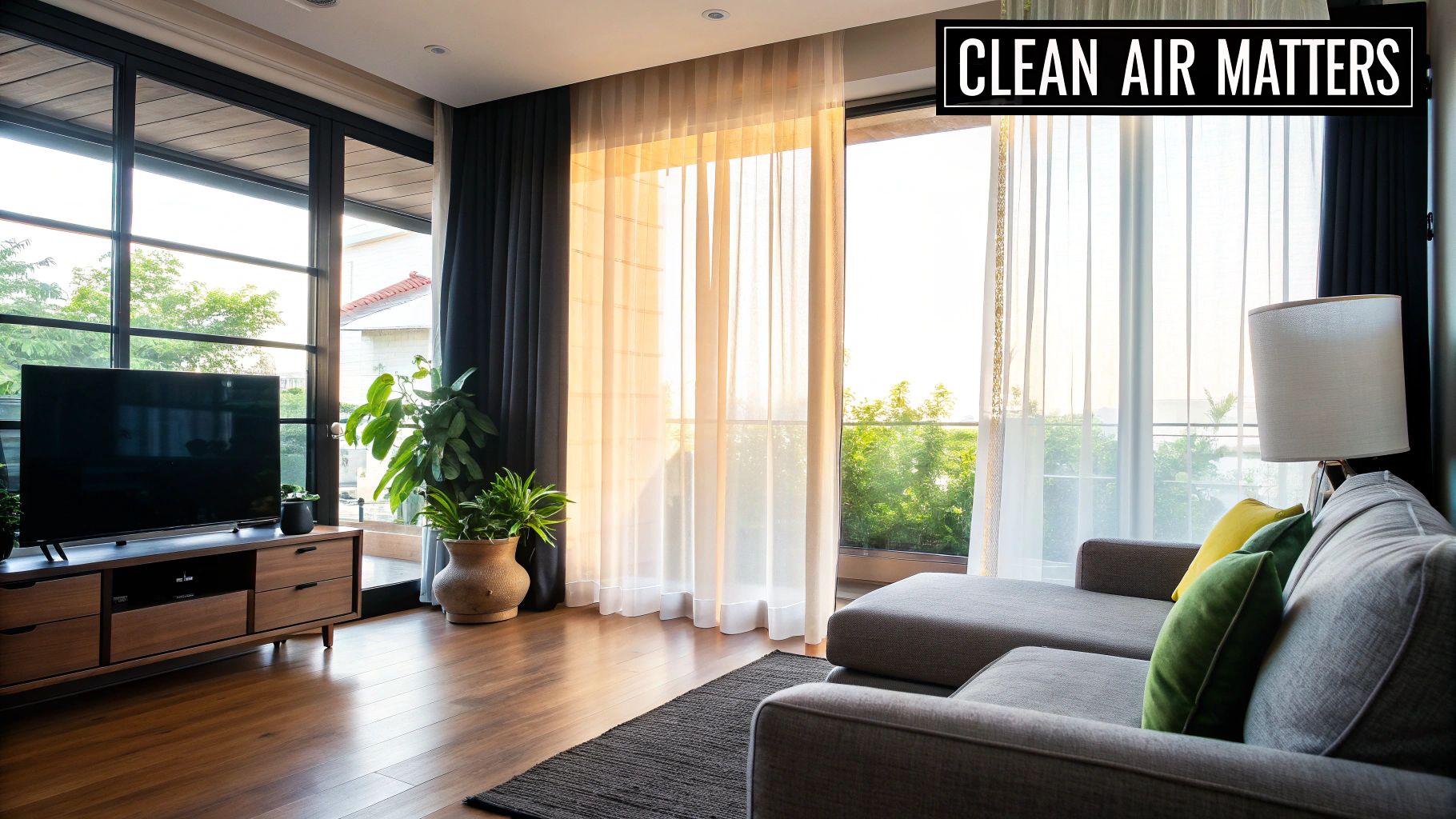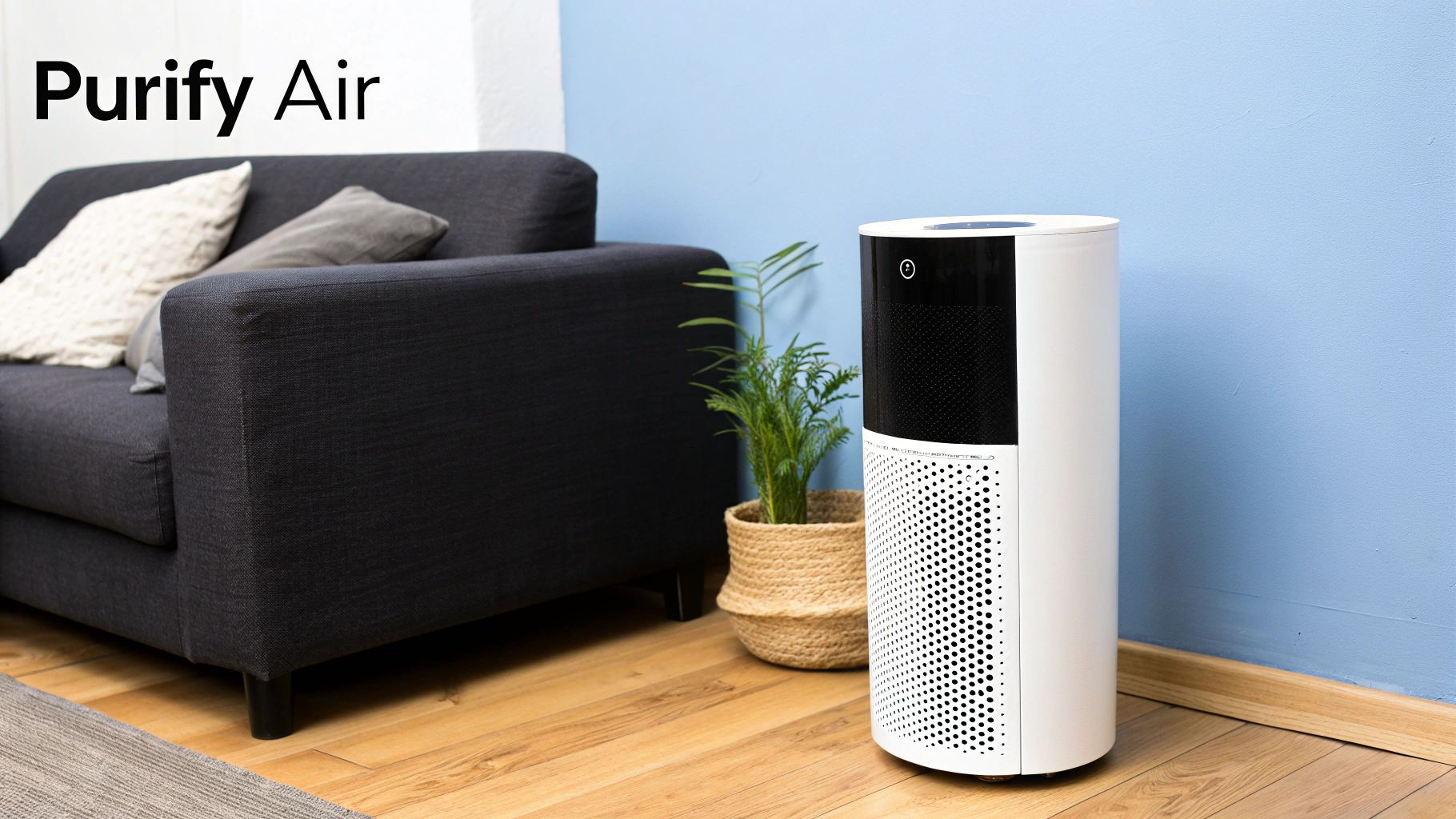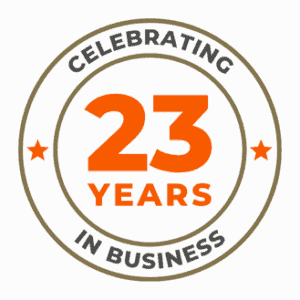For discerning homeowners in Orange County, the most significant threats to your family’s health and your property’s value often go completely unnoticed. It’s a critical truth: the air inside your home can be far more polluted than the air outside, trapping everything from dust and allergens to harmful chemicals right where you live, work, and breathe. This guide on indoor air quality improvement is designed to provide actionable, expert-led solutions.
The Hidden Air Quality Risks in Your Orange County Home

It’s an unfortunate irony. The very features that make our Southern California homes so desirable—energy-efficient windows, tight insulation, and powerful HVAC systems—can inadvertently work against us. While excellent for climate control, they also reduce natural ventilation, meaning any pollutants generated indoors have nowhere to go.
Given the EPA estimates that Americans spend about 90% of their day indoors, the quality of that air is paramount.
In prestigious Orange County communities like Newport Beach or Irvine, this issue is magnified by local conditions. Persistent smog, the seasonal threat of wildfires, and even our salty, humid coastal air can infiltrate your home and become trapped. This extends beyond simple comfort; it is a serious issue impacting your family’s health and, ultimately, your property’s integrity.
Why Modern Homes Are So Good at Trapping Pollutants
The “building envelope” of a modern luxury home is a double-edged sword. It’s superb at maintaining a comfortable temperature, but that same tight seal can lead to a significant buildup of contaminants that would normally dissipate.
These pollutants originate from a surprising number of everyday sources:
- Volatile Organic Compounds (VOCs): These are off-gassed from new furniture, fresh paint, carpets, high-end cleaning supplies, and even dry cleaning.
- Particulate Matter (PM2.5): These microscopic particles are generated by cooking, burning scented candles, fireplace smoke, and outdoor pollution that seeps indoors.
- Biological Pollutants: This category includes dust mites, pet dander, and mold spores, which thrive in humid or poorly ventilated spaces like bathrooms and laundry rooms.
When addressing any issue in your home, it’s crucial to select solutions that don’t trade one problem for another. For instance, when dealing with pests, exploring natural pest control methods is a far wiser choice than using chemical-laden pesticides that will linger in your air for weeks.
At Sparkle Restoration Services, we view indoor air quality as a foundational pillar of a healthy home. As an IICRC Master Certified firm and a BBB Torch Award Winner for Ethics, our reputation is built on creating safe, pristine living environments for our clients in Orange County. We have seen firsthand how clean air transforms a home.
Common Indoor Air Pollutants and Their Sources
To provide a clearer picture, here is a quick-reference table of common pollutants we frequently identify in Orange County homes and their typical sources.
| Pollutant | Common Sources in High-End Homes | Potential Health Effect |
|---|---|---|
| VOCs | New furniture, paint, luxury vinyl flooring, cleaning products, air fresheners | Headaches, dizziness, eye/nose/throat irritation, long-term organ damage |
| PM2.5 | Cooking fumes, gas stoves, candles, fireplaces, outdoor smog/wildfire smoke | Respiratory issues, asthma triggers, cardiovascular problems |
| Mold Spores | Damp basements, leaky pipes, poorly ventilated bathrooms, window condensation | Allergic reactions, asthma attacks, coughing, lung infections |
| Pet Dander | Dogs, cats, and other furry pets | Allergic reactions, sneezing, itchy eyes, respiratory distress |
| Carbon Monoxide (CO) | Malfunctioning furnaces, gas fireplaces, attached garages | Fatigue, confusion, nausea, and can be fatal at high concentrations |
| Radon | Natural breakdown of uranium in soil and rock beneath the foundation | Long-term exposure is a leading cause of lung cancer |
Understanding these sources is the first and most important step. Once you know what you’re facing, you can implement targeted improvements.
The Real-World Impact of Poor IAQ
The consequences of poor indoor air quality (IAQ) extend far beyond a stuffy nose or a musty odor. The World Health Organization has identified indoor air pollution as a major global health risk, attributing it to millions of premature deaths each year from diseases linked to fine particulate matter.
Proactively managing your home’s air isn’t a luxury; it’s a direct investment in your family’s long-term well-being. By understanding contaminant sources, you can take informed, effective steps to create a healthier home environment.
For a deeper analysis, you may find value in our guide that breaks down the primary sources of indoor air pollution in greater detail.
Pinpointing Your Home’s Air Quality Trouble Spots

To truly improve your home’s indoor air quality, the first step is essential: you must identify the pollution sources. Most homeowners we work with are surprised to learn the biggest culprits are not what they expect.
We see common scenarios throughout Orange County. Did you just complete a luxury remodel and now there’s a faint but persistent chemical odor? You’re likely smelling Volatile Organic Compounds (VOCs) off-gassing from new designer furniture, custom cabinetry, or fresh paint.
Or perhaps your allergies flare up the moment you walk inside. That’s a classic sign of an HVAC system circulating dust and dander instead of filtering them out. Before you can clear the air, you need to know what you’re up against.
A great starting point is understanding the common sources of endocrine disruptors, which are prevalent in everyday household items. This knowledge helps focus your efforts.
Uncovering Hidden Moisture and Mold Havens
One of the most insidious threats to your home’s air is hidden moisture. As IICRC-certified mold remediation experts, we’ve seen how even a tiny, slow leak behind a wall or under a high-end appliance can create the perfect breeding ground for mold. The spores it releases will degrade your air quality long before you spot visible growth.
Here’s a practical checklist to begin your own inspection:
- Under Sinks: Use a flashlight to check cabinets in your kitchen, bathrooms, and laundry room for dampness, water stains, or musty smells. These are ground zero for slow plumbing leaks.
- Around Windows: Look for condensation between panes or on sills, a frequent issue in our coastal climate. Persistent moisture can lead to mold on surrounding drywall and frames.
- HVAC Unit and Vents: Examine the area around your indoor air handler for any signs of water. Inspect air vents for black specks, which could indicate mold being distributed through your ductwork.
Here’s a key takeaway from our years in the field: If you smell a musty, earthy odor but see no source, do not ignore it. That smell is the number one indicator of a hidden mold problem that requires professional assessment.
When a DIY Check Isn’t Enough
A visual inspection is a fantastic first step, but it won’t catch everything. Many of the most harmful pollutants are invisible and odorless, like radon gas or the fine particulate matter from cooking. You also can’t see the microscopic mold spores your HVAC might be circulating.
This is where a professional assessment becomes invaluable. If you’ve conducted a walkthrough and still have concerns, or if a family member deals with chronic respiratory issues, it’s time to bring in an expert.
As a licensed General Contractor and restoration specialist, our team at Sparkle Restoration Services uses advanced diagnostic tools to pinpoint the exact source of contamination. We conduct air sampling, use thermal imaging to find hidden moisture, and perform a deep-dive evaluation of your home’s construction. This professional approach removes the guesswork, providing a clear, actionable plan to restore a healthy living environment.
Choosing the Right Ventilation and Filtration Systems
If you’re serious about improving your home’s indoor air quality, simply opening a window is insufficient, especially in Orange County. A genuine strategy for a high-end home rests on two pillars: advanced ventilation and high-performance filtration. These systems work in tandem to cycle out stale, polluted air and introduce fresh, clean air.
It’s about more than circulating the air you have. You need to actively introduce fresh air and, just as importantly, scrub it clean of contaminants before it enters your living space. This dynamic process goes beyond what a standard HVAC system is designed to do.
Advanced Ventilation for Modern Homes
Today’s luxury homes are built for incredible energy efficiency. While great for utility bills, the tight seals trap pollutants. This is where a whole-home ventilation system becomes a game-changer. Unlike cracking a window—which is inefficient and can let in smog or pollen—these systems manage your home’s air exchange intelligently.
- Heat Recovery Ventilators (HRVs): Fantastic for cooler climates, an HRV transfers heat from the stale air it expels to the fresh air it draws in, reducing the workload on your heating system.
- Energy Recovery Ventilators (ERVs): This is what we recommend most often for our clients in Southern California. An ERV transfers both heat and moisture. In summer, it pre-cools and dehumidifies incoming fresh air. In winter, it does the reverse. The result is a home that feels consistently fresh while maintaining comfortable humidity and boosting energy efficiency.
As a licensed General Contractor, we’ve integrated ERV systems into many luxury remodels in places like Newport Beach and Laguna Niguel. Without fail, our clients are impressed by the noticeable difference in air freshness and appreciate that it doesn’t cause a spike in their energy bills.
This isn’t just about comfort; there are tangible health benefits.

The connection between reducing indoor pollutants and enhancing daily life—from easier breathing to sharper thinking—is direct and powerful.
Demystifying Filtration: MERV and HEPA
Filtration is your home’s frontline defense. This is the job of your HVAC filter and any standalone purifiers, but not all filters are created equal.
The MERV (Minimum Efficiency Reporting Value) rating measures how well a filter captures airborne particles. For a typical home, a MERV 8-10 filter is adequate. But for clients with allergies, respiratory concerns, or a desire for premium air quality, a MERV 13 filter is the gold standard, capable of trapping much smaller particles like bacteria and wildfire smoke.
Of course, a filter can only do its job if the entire system is clean. Learn more in our guide on professional HVAC system cleaning.
For an even higher level of purification, nothing beats a standalone purifier with a True HEPA filter. These are engineered to capture 99.97% of airborne particles down to 0.3 microns. The best models also include an activated carbon layer, essential for adsorbing VOCs, cooking odors, and other harmful gases.
Even with progress in outdoor air regulations, the need for robust indoor solutions is clear. A 2025 report from the European Environment Agency highlighted that most of Europe’s urban population still breathes air exceeding WHO guidelines for PM2.5, underscoring the critical role of proper building ventilation and purification.
Mastering Moisture Control To Prevent Mold

As IICRC-certified professionals, we can state with certainty: where there is unchecked moisture, mold is not far behind. It is the single most destructive force against a home’s structure and the air you breathe.
This risk is elevated in luxury Orange County homes. With complex plumbing, high-end appliances, and features like steam showers, there are more opportunities for moisture to become a problem.
Many homeowners believe the solution is more filters and purifiers. But true indoor air quality improvement starts at the source. It’s about proactive moisture management—controlling humidity, preventing condensation, and addressing water intrusion immediately. This is a far more effective strategy.
Vigilance is key, especially in rooms prone to dampness. A standard exhaust fan often isn’t enough to prevent the exact conditions mold requires to thrive.
Proactive Strategies For High-Risk Areas
In our years serving communities from Newport Beach to Irvine, we’ve identified consistent trouble spots in high-end homes. Proactive attention here can prevent a massive remediation project later.
- Master Bathrooms with Steam Showers: These features pump significant moisture into the air. You must run your high-capacity exhaust fan during your shower and for 30-60 minutes afterward. A separate dehumidifier can help maintain the ideal 30-50% humidity level.
- Gourmet Kitchens: High-output stovetops and built-in coffee systems generate surprising amounts of steam. Use your range hood every time you cook. Regularly check plumbing under sinks and water lines to icemakers and dishwashers for slow leaks.
- Basements and Wine Cellars: These below-ground spaces are naturally damp. A quality, properly-sized dehumidifier is not an upgrade; it’s essential. Ensure sump pumps are functional and the foundation is sealed.
Another sneaky spot for moisture is windows, where condensation gathers. Learning how to prevent mold on window sills is a simple but effective preventative measure.
We’ve seen beautiful, custom-built homes suffer extensive damage from a small, undetected leak. Our most important advice is this: Act immediately at the first sign of water. Waiting even 24-48 hours can allow mold to take hold, turning a minor cleanup into a major restoration project.
The Critical Importance Of Immediate Action
When you have a water event—a burst pipe, appliance failure, or storm damage—time is your enemy. Mold can grow in as little as a day. Calling a professional is your best defense.
Attempting to clean up significant water damage yourself often leads to bigger problems. The real danger is the hidden mold that silently degrades your home’s air quality and structure.
As Orange County’s leading experts in mold remediation, we bring the advanced equipment and certified processes to remove moisture completely and restore your home safely.
Don’t let a water issue spiral. Calling a professional team like Sparkle Restoration Services immediately is the definitive step to “Turning Chaos Into Calm, Fast.” Our 24/7 emergency response is designed to protect your home, health, and peace of mind.
The Financial Sense of Investing in Clean Air
For homeowners in Orange County, every property decision is an investment. While the health benefits of improving your indoor air quality are clear, the financial upside is just as compelling. Think of clean air not as an expense, but as a strategic asset that adds tangible value.
A proactive stance on air quality directly protects your home’s market value. Issues like hidden mold, persistent odors, or moisture damage can seriously devalue a luxury property and deter discerning buyers. By investing in prevention, you sidestep these massive financial hits.
Protecting Your Assets and Well-being
An ounce of prevention is worth a pound of cure. The cost of preventing a problem is almost always a fraction of the cost to fix it.
Professional mold remediation or repairing water-damaged custom finishes can easily run into the tens of thousands of dollars and often trigger complex insurance claims. Navigating that process requires diligence, which is why we created a guide to property insurance claims for homeowners.
But the return on investment goes beyond avoiding remediation costs. Clean air offers a tangible ROI through better productivity and lower healthcare expenses. For the many executives and entrepreneurs in our community with a home office, better air quality leads to sharper cognitive function. Studies show that reducing indoor pollutants like PM2.5 and CO₂ can significantly boost concentration and decision-making.
An investment in your home’s air quality is a direct investment in your family’s health and your property’s long-term value. It’s one of the few home improvements that delivers daily returns in well-being while safeguarding your most significant financial asset.
The economic case is powerful. A recent World Bank report projected that halving our exposure to dangerous PM2.5 could create global economic benefits worth US$2.4 trillion by 2040 from saved healthcare costs, increased productivity, and longer life expectancy—proving clean air is a prudent economic choice.
Your Indoor Air Quality Questions Answered
Improving your home’s air can feel complex. To provide clarity and confidence, our IICRC Master Certified experts have answered the most common questions we hear from homeowners across Orange County.
Is an Expensive Air Purifier Really Necessary?
This is a great question. While a high-quality, standalone air purifier with a True HEPA filter is excellent for specific rooms like a bedroom or home office, it’s just one piece of the puzzle.
Truly effective indoor air quality improvement requires a layered approach. It’s a complete system: control moisture, ensure whole-house ventilation, and upgrade your HVAC filter to at least a MERV 13 rating. A purifier is a powerful tool, but it can’t fix an underlying problem like a hidden mold source.
How Often Should I Replace My HVAC Filter?
The answer depends on your specific household. Here is our general rule of thumb based on years of experience serving Orange County homeowners:
- Standard Homes: For a typical home without pets or major allergies, change your filter every 90 days.
- Homes with Pets: If you have pets, check the filter monthly and replace it every 60 days to manage dander.
- Allergy Sufferers or Smokers: In homes where allergies are a concern or if someone smokes indoors, replace the filter every 30-45 days.
During Southern California’s wildfire season, check your filter more frequently, regardless of your regular schedule.
As a BBB Torch Award Winner for Ethics, we believe in giving honest, practical advice. Be wary of “permanent” or “washable” filters. In our experience, they often lose effectiveness and can grow mold if not dried perfectly—creating a new air quality problem.
Can I Test My Home’s Air Quality Myself?
DIY air quality monitors offer a general sense of your home’s environment. They can track CO₂, humidity, and particulate matter, which is useful for spotting trends, like a pollutant spike during cooking.
However, these consumer-grade devices cannot identify specific mold species or detect dangerous substances like radon or low-level VOCs. If you have persistent health issues, smell a musty odor, or have had recent water damage, a professional assessment by a certified expert is the only way to get a definitive, actionable diagnosis.
Are you ready to stop guessing and start breathing cleaner, healthier air in your Orange County home? The certified experts at Sparkle Restoration Services use advanced diagnostics to pinpoint hidden issues and create a customized plan for lasting indoor air quality improvement.
Schedule your free, no-obligation consultation today and experience the peace of mind that comes with proven expertise.

